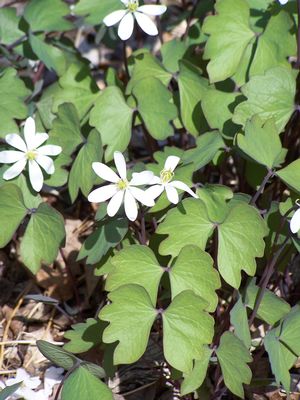View All Plants :: View All QUACKIN' GRASS INTRODUCTIONS :: View All SHADE PERENNIALS
Jeffersonia diphylla 'Monkey Wings'
Twinleaf
Plant Type:
QUACKIN' GRASS INTRODUCTIONSJeffersonia diphylla ‘Monkey Wings’ EXCLUSIVE! – This selection of Jeffersonia diphylla displays beautiful sets of lobes which suggest paired wings in place of the usual paired kidneys that are a distinctive trait of Twinleaf. I named this selection ‘Monkey Wings’ for the flying monkeys in the Wizard of Oz. We’re fed up, frankly, with all the “cutie pie” plant names and lean with a decided preference towards darkness and grit! The young emerging leaves do not demonstrate the lobes as found on the mature foliage. Your patience will pay off. The interest will develop but it takes time. We will only offer this plant as a division from our plants so that you will be assured of a true-to-name clone. A small percentage of seedlings may come relatively “true” to form. But to offer them as ‘Monkey Wings’ genetically waters down the truth. Only one will be available per customer. Be certain to check availability numbers before ordering. Order ‘Monkey Wings’ early as we are likely to only ever have a few available annually.
For a more in depth discussion please see the article about Jeffersonia diphylla in the HERALD section of our website under Plant Portraits. There is more text regarding this wonderful monotypic genus, just scroll down...
More About Jeffersonia diphylla 'Monkey Wings'
- EXCLUSIVE!
Characteristics and Attributes for Jeffersonia diphylla 'Monkey Wings'
Season of Interest (Flowering)
- Spring
Season of Interest (Foliage)
- Spring / Summer
Autumn Interest
- Fruit / Berries / Seed Heads
Nature Attraction
- Deer Resistant
Light
- Morning Sun / Afternoon Shade
- Dappled Shade
- Shade
Attributes
- Specimen
- Natural Garden
- Woodland
- Rock Garden
Growth Rate in the Garden
- Slow
Soil
- Fertile
- Draining
Origins
- Quackin' Grass Nursery
Propagated By
- Division
Genus Overview: Jeffersonia
Common Name: Twinleaf
Twinleaf. Each wiry stem supports a pair of mirrored kidney-shaped leaves. The ephemeral flowers in April-May are cupped daisies in a light pink to white tint. They are followed by pear-shaped seed pods that suddenly pop open spewing forth the small seed. The dried seed pods look like little stylized Jack-in-the-pulpits and can be used in small autumn/winter dried arrangements. Though not found in New England it is hardy for us in the southern reaches of the Northeast. Named for Thomas Jefferson, this most handsome member of the Berberidaceae looks great all season in the woodland garden. Site them in draining soil in dappled to open shade conditions. The following are offered by division. We’re likely to only have but a few available annually as they resent disturbance and are then very slow to size up. Be certain to check availability numbers before ordering. Only one per customer and please order early.


